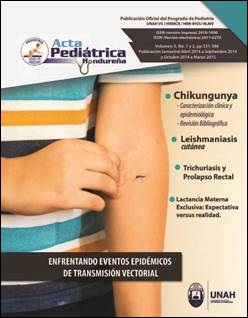Complicated pleuropulmonary disease in pediatric patients
DOI:
https://doi.org/10.5377/pediatrica.v5i1-2.2254Keywords:
Pleural effusion, Pneumonia, bacterial, Streptococcus pneumoniae, Staphylococcus aureusAbstract
Background: Pneumonia has great connotations in pediatrics due to its incidence, severity potential and high mortality. Complicated Pleuropulmonary Disease (CPPD) occurs in up to 40% of cases.
Objectives: To determine the clinical, radiologic and microbiological characteristics of the CPPD in children admitted to the pediatric ward at the Dr. Mario Catarino Rivas National Hospital (HNMCR) between October 2013 and October 2014.
Patients and Methods: This is an transversal study of 21 children between 28 days and 18 years of age with CPPD admitted to the Pediatric ward. The data of hospitalization until discharge was collected from each patient´s record.
Results: 62% of children with CPPD were older than 5 years. The male to female ratio was 1: 1. 24% of patients were malnourished. 5 types of CPPD were diagnosed; the most common were empyema in 6 patients (29%) and pyopneumothorax in 5 patients (24%). S. aureus and S. pneumoniae were isolated from pleural fluid in 44% and 22% of cases respectively. 36% of the cultures were negative.
Conclusions: Patients with CPPD were mainly eutrophic school-age children and adolescents. There is no evidence that malnourishment is a risk factor for CPPD. There is a direct relationship between the time of onset of symptoms, and the most advanced forms of CPPD.
Acta Pediátrica Hondureña, Vol. 5, No. 1 & 2 / April 2014 - March 2015: 343-348
Downloads
1327

